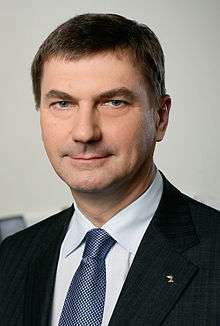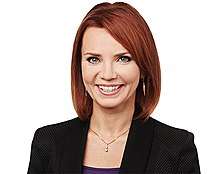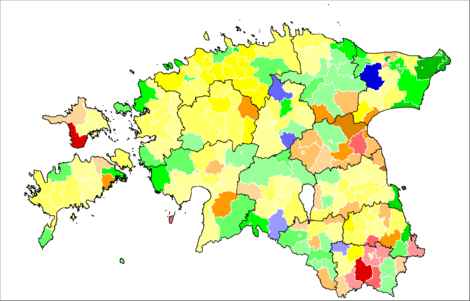Estonian Reform Party
The Estonian Reform Party (Estonian: Eesti Reformierakond) is a classical-liberal[4] political party in Estonia. The party is led by Kaja Kallas and has 34 members in the 101-member Riigikogu, making it the largest party in the legislature.
Estonian Reform Party Eesti Reformierakond | |
|---|---|
 | |
| Leader | Kaja Kallas |
| Founder | Siim Kallas |
| Founded | 18 November 1994 |
| Headquarters | Tõnismägi 9 10119 Tallinn |
| Youth wing | Estonian Reform Party Youth |
| Membership (2019) | |
| Ideology | Classical liberalism |
| Political position | Centre-right[2][3] |
| European affiliation | Alliance of Liberals and Democrats for Europe Party |
| International affiliation | Liberal International |
| European Parliament group | Renew Europe |
| Colours | Yellow |
| Riigikogu | 34 / 101 |
| European Parliament | 2 / 7 |
| Website | |
| reform | |
The party was founded by then-President of the Bank of Estonia Siim Kallas as a split from National Coalition Party Pro Patria. At the 1995 election, it won 19 seats in the Riigikogu, making it the second largest party. The Reform Party replaced the Estonian Centre Party in government in autumn 1995, and remained there until 1996. In 1999, the party lost a seat, but returned to the cabinet in coalition with the Pro Patria Union and the Moderate People's Party. The party has remained in various coalitions since then, with Andrus Ansip as Prime Minister since 2005. At the 2007 parliamentary election, the party won 31 seats, becoming the largest party for the first time, and increased its seat tally again in 2011, with 33 seats. It narrowly won the 2015 general election, losing 3 mandates compared to its 2011 result, ending up with 30 seats. After being in opposition since November 2016, the party won the 2019 parliamentary election with a convincing lead and expanded its number of mandates to 34.
As the Reform Party has participated in most of the government coalitions in Estonia since the mid-1990s, its influence has been significant, especially regarding Estonia's free market and low taxes policies. The party has been a full member of Liberal International since 1996, having been an observer member between 1994–1996, and a full member of the Alliance of Liberals and Democrats for Europe (ALDE). The founder and the first chairman of the Reform Party, Siim Kallas, was a Commissioner of the European Commission between 2004 and 2014. He was also one of the five Vice Presidents of the Barroso Commission.
History
The Estonian Reform Party was founded on 18 November 1994,[5] joining together the Reform Party – a splinter from the Pro Patria National Coalition (RKEI) – and the Estonian Liberal Democratic Party (ELDP). The new party, which had 710 members at its foundation,[5] was led by Siim Kallas, who had been President of the Bank of Estonia and previously uninvolved in politics. Kallas was untainted by association with Mart Laar's government, but was widely seen as a proficient central bank governor, having overseen the successful introduction of the Estonian kroon.[6] The party formed ties with the Free Democratic Party of Germany, the Liberal People's Party of Sweden, the Swedish People's Party of Finland, and Latvian Way.[5]
Siim Kallas
Siim Kallas was leader of the Reform Party from 1994 to 2004. He was Prime Minister of Estonia from 2002 to 2003. In the party's first parliamentary election in March 1995, it won 19 seats: catapulting it into second place, behind the Coalition Party. Tiit Vähi tried to negotiate a coalition with the Reform Party, but the talks broke down over economic policy,[7] with the Reform Party opposing agricultural subsidies and supporting the maintenance of Estonia's flat-rate income tax,[6] While the Coalition Party formed a new government with the Centre Party at first, a taping scandal involving Centre Party leader Edgar Savisaar led to the Reform Party replacing the Centre Party in the coalition in November 1995.[8] Kallas was appointed as Minister of Foreign Affairs, with five other Reform Party members serving in the cabinet. The Reform Party left the government in November 1996 after the Coalition Party signed a cooperation agreement with the Centre Party without consulting them.[8]
At the 1999 election, the Reform Party dropped one seat to 18, finishing third behind the Centre Party and the conservative Pro Patria Union.[9] The ER formed a centre-right coalition with the Pro Patria Union and the Moderates, with Mart Laar as Prime Minister and Siim Kallas as Minister of Finance, and with Toomas Savi returned as Speaker.[9] Although the coalition was focused on EU and NATO accession, the Reform Party successfully delivered its manifesto pledge to abolish corporate tax:[9] one of its most notable achievements.[10] After the October 1999 municipal elections, the three parties replicated their alliance in Tallinn.[11]
The party served in government again from March 1999 to December 2001 in a tripartite government with Pro Patria Union and People's Party Moderates, from January 2002 to March 2003 with the Estonian Centre Party, from March 2003 to March 2005 with Res Publica and People's Union, from March 2005 to March 2007 with the Centre Party and People's Union, from March 2007 to May 2009 with the Pro Patria and Res Publica Union and the Social Democratic Party. From May 2009 the Reform Party was in a coalition government with the Pro Patria and Res Publica Union.
Andrus Ansip

Andrus Ansip was Prime Minister of Estonia from April 2005 to March 2014. After the 2007 parliamentary election the party held 31 out of 101 seats in the Riigikogu, after receiving 153,040 votes (28% of the total), an increase of +10%, resulting in a net gain of 12 seats.
Taavi Rõivas

Following the resignation of Andrus Ansip, a new cabinet was installed on 24 March 2014, with Taavi Rõivas of the Reform Party serving as Prime Minister in coalition with the Social Democratic Party (SDE).[12]
In the 2014 European elections held on 25 May 2014, the Reform Party won 24.3% of the national vote, returning 2 MEPs.[13]
In the 2015 parliamentary election held on 1 March 2015, the Reform Party received 27.7% of the vote and 30 seats in the Riigikogu.[14] It went on to form a coalition with Social Democratic Party and Pro Patria and Res Publica Union. In November 2016, the coalition split due to internal struggle.[15] After coalition talks, a new coalition was formed between Center Party, SDE and IRL, while Reform Party was left in the opposition for the first time since 1999.[16] Rõivas subsequently stepped down as the chairman of the party.[17]
Hanno Pevkur
On 7 January 2017, Hanno Pevkur was elected the new chairman of the Reform Party.[18] Pevkur's leadership was however divided since the beginning and he faced increasing criticism till the end of the year. On 13 December 2017, Pevkur announced that he would not run for the chairmanship anymore in January 2018.[19]
Kaja Kallas
Kaja Kallas was elected party leader on 14 April 2018.[20]
Under her leadership during the 2019 election, the Reform Party achieved its best result in party history with 28.8% of the vote and 34 seats, although it did not form a government.
Ideology
The Estonian Reform Party has been referred to as liberal,[21][22] classical-liberal,[4] and liberal-conservative[23][24] in ideological orientation.
Ideologically, the party has consistently advocated market liberalism.[10] The Reform Party is the most economically liberal in the political landscape of Estonia.
- The party supports Estonian 0% corporate tax on re-invested income and wants to eliminate the dividend tax.
- The party wanted to cut flat income tax rate from 22% (in 2007) to 18% by 2011. Due to economic crisis the campaign for cutting income tax rate was put on hold with the tax rate at 21% in 2008 and 2009.
- The party used to oppose VAT general rate increase until late spring 2009 when it changed its position in the light of dire economic crisis and the need to find more money for budget. VAT was increased from 18% to 20% on 1 July 2009.[25]
_(cropped).jpg)

Political support

The party is supported predominantly by young, well-educated, urban professionals. Unlike the Centre Party, which has disproportionate appeal among the Russian minority, and the Union of Pro Patria and Res Publica, which is overwhelmingly backed by ethnic Estonians, the Reform Party attracts votes from equally across populations.[26] The Reform Party's vote base is heavily focused in the cities; although it receives only one-fifth of its support from Tallinn, it receives three times as many votes from other cities, despite them being home to fewer than 40% more voters overall.[26]
Its voter profile is significantly younger than average,[27] while its voters are well-educated, with the fewest high school drop-outs of any party.[26] Its membership is the most male-dominated of all the parties,[28] yet it receives the support of more female voters than average.[27] Reform Party voters also tend to have higher incomes, with 43% of Reform Party voters coming from the top 30% of all voters by income.[26]
Organisation
The Reform Party has been a full member of the Alliance of Liberals and Democrats for Europe Party (formerly the European Liberal Democrat and Reform Party, ELDR) since December 1998.[29] In the European Parliament, the party's MEPS Andrus Ansip and Urmas Paetsits in the ALDE group in the Assembly. The Reform Party has been a full member of the Liberal International since 1996, having been an observer member from 1994 to 1996.
The party claims to have 12,000 members.[30]
The party's youth wing is the Estonian Reform Party Youth, which includes members aged 15 to 35. The organisation claims to have 4,500 members. Leader of the youth wing is Katarina Elisabeth Saage.[31]Reformierakonna noortekogu
Election results
| Election | Votes | % | Seats | +/– | Position | Government |
|---|---|---|---|---|---|---|
| 1995 | 87,531 | 16.2 | 19 / 101 |
Opposition | ||
| 1999 | 77,088 | 14.9 | 18 / 101 |
Coalition | ||
| 2003 | 87,551 | 17.7 | 19 / 101 |
Coalition | ||
| 2007 | 153,044 | 27.8 | 31 / 101 |
Coalition | ||
| 2011 | 164,255 | 28.6 | 33 / 101 |
Coalition | ||
| 2015 | 158,885 | 27.7 | 30 / 101 |
Coalition (2015–2016) | ||
| 2019 | 162,332 | 28.8 | 34 / 101 |
Opposition |
See also
Footnotes
- "Äriregistri teabesüsteem" (in Estonian). Retrieved 1 January 2019.
- Vello Pettai (2019). "Estonia: From Instability to the Consolidation of Centre-Right Coalition Politics". In Torbjörn Bergman; Gabriella Ilonszki; Wolfgang C. Müller (eds.). Coalition Governance in Central Eastern Europe. Oxford University Press. pp. 170–185. ISBN 978-0-19-884437-2.
- Kjetil Duvold; Sten Berglund; Joakim Ekman (2020). Political Culture in the Baltic States: Between National and European Integration. Springer Nature. p. 72. ISBN 978-3-030-21844-7.
- Caroline Close; Pascal Delwit (2019). "Liberal parties and elections: Electoral performances and voters' profile". In Emilie van Haute; Caroline Close (eds.). Liberal Parties in Europe. Taylor & Francis. p. 295. ISBN 978-1-351-24549-4.
- Bugajski (2002), p. 64
- Nørgaard (1999), p. 75
- Dawisha, Karen; Parrott, Bruce (1999). The Consolidation of Democracy in East-Central Europe. London: Edward Elgar Publishing. p. 352. ISBN 978-1-85898-837-5.
- Europa Publications (1998), p 336
- Bugajski (2002), p. 52
- Berglund et al (2004), p 67
- Bugajski (2002), p. 53
- "Archived copy". Archived from the original on 2 April 2015. Retrieved 6 March 2015.CS1 maint: archived copy as title (link)
- "Euroopa Parlamendi valimised".
- "Riigikogu valimised".
- "Prime Minister loses no confidence vote, forced to resign". ERR. 9 November 2016. Retrieved 9 November 2016.
- "49th cabinet of Estonia sworn in under Prime Minister Jüri Ratas". ERR. 23 November 2016. Retrieved 23 November 2016.
- "Reform Party chairmanship debate behind closed doors, internal voting to end on Thursday". ERR. 5 January 2017. Retrieved 11 January 2017.
- "Hanno Pevkur elected new Reform Party chairman". ERR. 8 January 2017. Retrieved 11 January 2017.
- "Pevkur not to run for Reform lead again, Kallas not announcing yet". ERR. 13 December 2017. Retrieved 22 December 2017.
- "Estonia's struggling Reform Party picks first female leader". The Sydney Morning Herald. 15 April 2018. Retrieved 17 April 2018.
- Mindaugas Kuklys (2014). "Recruitment of parliamentary representatives in an ethno-liberal democracy". In Elena Semenova; Michael Edinger; Heinrich Best (eds.). Parliamentary Elites in Central and Eastern Europe: Recruitment and Representation. Routledge. p. 101. ISBN 978-1-317-93533-9.
- Elisabeth Bakke (2010). Sabrina P. Ramet (ed.). Central and East European party systems since 1989. Central and Southeast European Politics since 1989. Cambridge University Press. pp. 78–79. ISBN 978-1-139-48750-4.
- Alari Purju (2003). "Economic Performance and Market Reforms". In Marat Terterov; Jonathan Reuvid (eds.). Doing Business with Estonia. GMB Publishing Ltd. p. 20. ISBN 978-1-905050-56-7.
- Kjetil Duvold (2017). "When Left and Right is a Matter of Identity: Overlapping Political Dimensions in Estonia and Latvia". In Andrey Makarychev; Alexandra Yatsyk (eds.). Borders in the Baltic Sea Region: Suturing the Ruptures. Springer. p. 132. ISBN 978-1-352-00014-6.
- "Eesti Rahvus Ringhääling". 21 August 2014.
- Berglund et al (2004), p 65
- Kulik and Pshizova (2005), p. 153
- Kulik and Pshizova (2005), p. 151
- "History : ELDR 1976 – 2009". European Liberal Democrat and Reform Party. Archived from the original on 2 March 2009. Retrieved 29 August 2011.
- "Organisatsioon" (in Estonian). Estonian Reform Party. Retrieved 29 August 2011.
- "Noortegku" (in Estonian). Estonian Reform Party Youth. Archived from the original on 20 August 2011. Retrieved 29 August 2011.
References
- Bugajski, Janusz (2002). Political Parties of Eastern Europe: A Guide to Politics in the Post-Communist Era. London: M. E. Sharpe. ISBN 978-1-56324-676-0.
- Europa Publications (1998). Eastern Europe and the Commonwealth of Independent States. London: Routledge. ISBN 978-1-85743-058-5.
- Nørgaard, Ole (1999). The Baltic States After Independence. London: Edward Elgar Publishing. ISBN 978-1-85898-837-5.
- Berglund, Sten; Ekman, Joakim; Aarebrot, Frank H. (2004). The Handbook of Political Change in Eastern Europe. London: Edward Elgar Publishing. ISBN 978-1-84064-854-6.
- Kulik, Anatoly; Pshizova, Susanna (2005). Political Parties in Post-Soviet Space: Russia, Belarus, Ukraine, Moldova, and the Baltics. New York: Greenwood Publishing Group. ISBN 978-0-275-97344-5.
External links
- Official website (in Estonian)
- Estonian Reform Party faction description of the party on the Riigikogu website